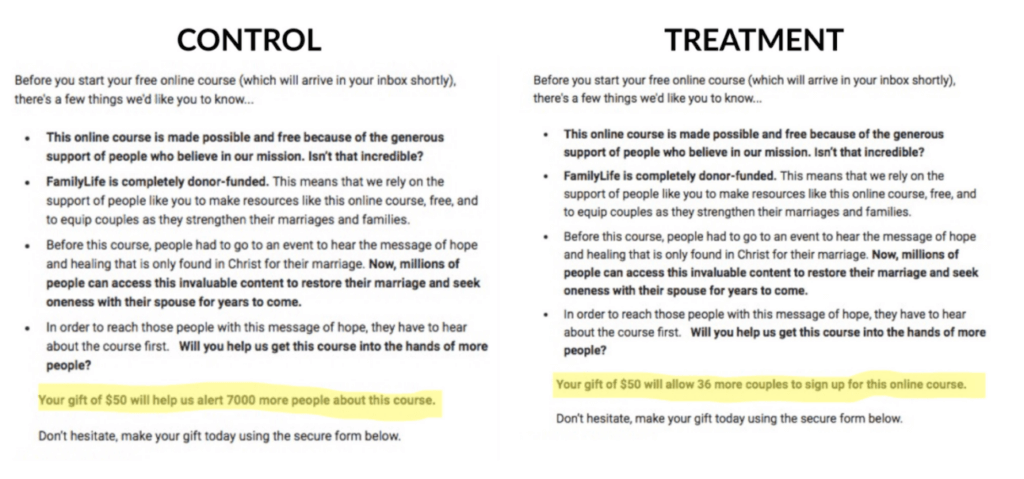Every donor who gives to you has an incentive that motivates them. But can you add incentives to raise more donors? Let’s take a look at the research.
We’ve looked at the research behind giving motives and how you can increase giving desire in your donors.
In that conversation, we discussed the interior motives your donor has to give and how you can help increase those natural motives in them to give to you.
But what if you could add something to the mix, something from your end, that would increase giving desire that doesn’t start with the donor?
These are often called incentives.
Now, this is important: Incentives are not your value proposition or the reason to give.
Incentives are additional encouragement to persuade someone to give today or to give more.
They are not a replacement for a donor’s internal giving motive.
If a donor doesn’t want to give to you—or they don’t believe in your cause—there’s nothing you can give them that would make them give.
(Besides that, even if you could bribe them to give to you, you’ll have to keep paying out lots of money to renew their giving year over year. This is no way the way to raise donors.)
Incentives do NOT make unwilling donors suddenly willing to give to your nonprofit.
So again, incentives really only do one thing…
They convince already ready donors to give today rather than wait for another time.
Incentives come in many packages.
Some examples of incentives you can use are:
- Tangible or physical, like gifts — “If you give $50 today, we’ll send you a tote bag.”
- Matching gifts — “If you give today, your gift will be doubled.”
- Quantifiable impact — “A gift of $30 does … ”
- Giving level — “$100 for a Bronze membership, $500 for a Silver membership, $1000 for a Gold membership”
- Overhead — “100% of your donation will go to program … ”
- Premium content — “As a donor, you’ll have access to this special content … ”
How are nonprofits using incentives in their fundraising?
In our research in the State of Nonprofit Donation Pages Report, we found that 36% of nonprofits used an incentive.
Most organizations used quantifiable impact, helping donors understand exactly what their gift amount could do.
The second most used incentive we saw in the study was physical items like books or tote bags that were sent to donors who gave.
The least used incentive was overhead covering, assuring donors that their donation would go completely to programming.
Quantifying Impact
Of the different incentives we looked for, organizations were most likely to use quantifiable impact.
Through very direct, clear, and tangible statements like “$30 does X” you can help donors make a decision on how much they should give.
But does helping donors quantify the impact of their gift help motivate giving?
Yes, absolutely.
In this experiment in the study, we saw how increasing the clarity of the value proposition affects donor conversion rate.
By telling donors that their donation of $30 could keep the organization’s site up and running for a month, they increased conversions by 64%.
For many people who give between $30-$150, it’s hard for them to feel like their donation will make a real difference in the face of the complex problems you are trying to solve. It feels futile.
By adding in this quantifiable impact, you can help donors understand the difference that even $30 can make.
This can have a big impact on the conversion rate.
But we found something else in the research that can help you increase conversions.
Try being more tangible and specific with the impact of someone’s donation.
Sometimes the specific kind of impact you quantify is important.
In another experiment in the study, there was a donation page shown immediately after someone signed up to take a free online course on marriage.
In the control version, they said, “Your gift of $50 will help us alert 7000 more people about this course.”
But in the treatment version, they said, “Your $50 gift will allow 36 more couples to sign up for this online course.”

The result? A 98.4% increase!
Think of this through the eyes of your donor. They just signed up for a marriage course.
Do you think they care about helping 7000 other random people?
Or do they care about helping 36 other couples like them?
This also taps into something called “construal theory,” where narrowing the gap between who I am and who I am helping can help increase donations.
Quantifying impact is one of the most effective incentives you can put to use right away in your fundraising copy to increase conversions on your donation pages.
Does the matching gift incentive work?
Let’s focus on matching gifts for a minute.
In this experiment in the study, we looked closely at one organization’s attempt to use matching gifts as an incentive.
Over the course of three emails in a fundraising campaign, they sent the control group messages with no matching language.
The treatment group received the same appeal but with the addition of matching language: “If you give today, your donation will be matched.”
At the end of the campaign, those that received the matching offer and language were almost 88% more likely to give.
Matching, on average, helps increase giving.
It’s well worth the effort to seek matching gift donors so that you can create matching gift campaigns.
As you can see, adding incentives in your fundraising copy can have a big impact on your donation pages’ conversion rates.
Think about the kinds of incentives you can add to help your donors make a decision to give today.





